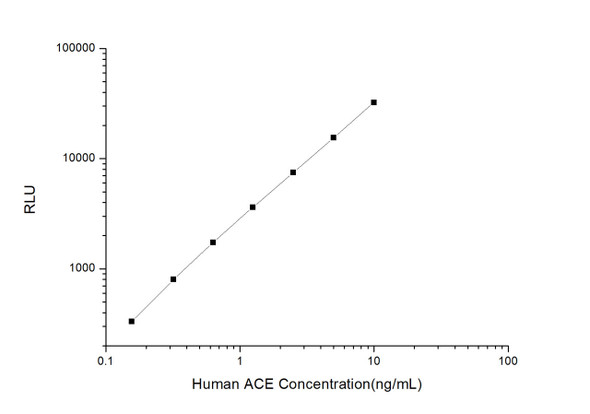Mouse Cell Signalling ELISA Kits 2
Mouse ACE (Angiotensin I Converting Enzyme) CLIA Kit (MOES00070)
- SKU:
- MOES00070
- Product Type:
- ELISA Kit
- ELISA Type:
- CLIA Kit
- Size:
- 96 Assays
- Sensitivity:
- 37.5pg/mL
- Range:
- 62.5-4000pg/mL
- ELISA Type:
- Sandwich
- Synonyms:
- ACE1, CD143, DCP, DCP1, ICH, MVCD3
- Reactivity:
- Mouse
- Sample Type:
- Serum, plasma and other biological fluids
Description
| Assay type: | Sandwich |
| Format: | 96T |
| Assay time: | 4.5h |
| Reactivity: | Mouse |
| Detection method: | Chemiluminescence |
| Detection range: | 62.50-4000 pg/mL |
| Sensitivity: | 37.50 pg/mL |
| Sample volume: | 100µL |
| Sample type: | Serum, plasma and other biological fluids |
| Repeatability: | CV < 15% |
| Specificity: | This kit recognizes Mouse ACE in samples. No significant cross-reactivity or interference between Mouse ACE and analogues was observed. |
This kit uses Sandwich-CLIA as the method. The micro CLIA plate provided in this kit has been pre-coated with an antibody specific to Mouse ACE. Standards or samples are added to the appropriate micro CLIA plate wells and combined with the specific antibody. Then a biotinylated detection antibody specific for Mouse ACE and Avidin-Horseradish Peroxidase (HRP) conjugate are added to each micro plate well successively and incubated. Free components are washed away. The substrate solution is added to each well. Only those wells that contain Mouse ACE, biotinylated detection antibody and Avidin-HRP conjugate will appear fluorescence. The Relative light unit (RLU) value is measured spectrophotometrically by the Chemiluminescence immunoassay analyzer. The RLU value is positively associated with the concentration of Mouse ACE. The concentration of Mouse ACE in the samples can be calculated by comparing the RLU of the samples to the standard curve.
| UniProt Protein Function: | ACE: Converts angiotensin I to angiotensin II by release of the terminal His-Leu, this results in an increase of the vasoconstrictor activity of angiotensin. Also able to inactivate bradykinin, a potent vasodilator. Has also a glycosidase activity which releases GPI-anchored proteins from the membrane by cleaving the mannose linkage in the GPI moiety. Genetic variations in ACE may be a cause of susceptibility to ischemic stroke (ISCHSTR); also known as cerebrovascular accident or cerebral infarction. A stroke is an acute neurologic event leading to death of neural tissue of the brain and resulting in loss of motor, sensory and/or cognitive function. Ischemic strokes, resulting from vascular occlusion, is considered to be a highly complex disease consisting of a group of heterogeneous disorders with multiple genetic and environmental risk factors. Defects in ACE are a cause of renal tubular dysgenesis (RTD). RTD is an autosomal recessive severe disorder of renal tubular development characterized by persistent fetal anuria and perinatal death, probably due to pulmonary hypoplasia from early-onset oligohydramnios (the Potter phenotype). Genetic variations in ACE are associated with susceptibility to microvascular complications of diabetes type 3 (MVCD3). These are pathological conditions that develop in numerous tissues and organs as a consequence of diabetes mellitus. They include diabetic retinopathy, diabetic nephropathy leading to end-stage renal disease, and diabetic neuropathy. Diabetic retinopathy remains the major cause of new- onset blindness among diabetic adults. It is characterized by vascular permeability and increased tissue ischemia and angiogenesis. Defects in ACE are a cause of susceptibility to intracerebral hemorrhage (ICH). A pathological condition characterized by bleeding into one or both cerebral hemispheres including the basal ganglia and the cerebral cortex. It is often associated with hypertension and craniocerebral trauma. Intracerebral bleeding is a common cause of stroke. Belongs to the peptidase M2 family. 4 isoforms of the human protein are produced by alternative splicing. |
| UniProt Protein Details: | Protein type:Protease; Membrane protein, integral; EC 3. 4. 15. 1 Cellular Component: extracellular space; membrane; brush border membrane; lysosome; cytoplasm; plasma membrane; integral to membrane; basal plasma membrane; extracellular region; endosome; vesicle; external side of plasma membrane Molecular Function:metallopeptidase activity; carboxypeptidase activity; zinc ion binding; mitogen-activated protein kinase kinase binding; mannosyl-oligosaccharide mannosidase activity; metal ion binding; drug binding; actin binding; glucosidase activity; endopeptidase activity; mitogen-activated protein kinase binding; amylase activity; chloride ion binding; peptidyl-dipeptidase activity; tripeptidyl-peptidase activity; hydrolase activity; trehalase activity; peptidase activity; protein binding; fucosidase activity; hexosaminidase activity; lytic transglycosylase activity; galactosidase activity; bradykinin receptor binding; exopeptidase activity; mannosidase activity Biological Process: positive regulation of protein binding; positive regulation of apoptosis; neutrophil mediated immunity; response to lipopolysaccharide; positive regulation of systemic arterial blood pressure; regulation of angiotensin metabolic process; proteolysis; sensory perception of pain; peptide metabolic process; regulation of smooth muscle cell migration; peptide catabolic process; beta-amyloid metabolic process; regulation of blood pressure; kidney development; negative regulation of protein binding; vasoconstriction; positive regulation of neurogenesis; organ regeneration; eating behavior; arachidonic acid secretion; regulation of systemic arterial blood pressure by renin-angiotensin; heart contraction; spermatogenesis; hormone catabolic process; alveolus development; positive regulation of inflammatory response |
| UniProt Code: | P09470 |
| NCBI GenInfo Identifier: | 73920183 |
| NCBI Gene ID: | 11421 |
| NCBI Accession: | P09470. 3 |
| UniProt Related Accession: | P09470 |
| Molecular Weight: | |
| NCBI Full Name: | Angiotensin-converting enzyme |
| NCBI Synonym Full Names: | angiotensin I converting enzyme (peptidyl-dipeptidase A) 1 |
| NCBI Official Symbol: | Ace |
| NCBI Official Synonym Symbols: | CD143; AW208573 |
| NCBI Protein Information: | angiotensin-converting enzyme |
| UniProt Protein Name: | Angiotensin-converting enzyme |
| UniProt Synonym Protein Names: | Dipeptidyl carboxypeptidase I; Kininase II; CD_antigen: CD143Cleaved into the following chain:Angiotensin-converting enzyme, soluble form |
| Protein Family: | Acetylcholinesterase |
| UniProt Gene Name: | Ace |
| UniProt Entry Name: | ACE_MOUSE |
As the RLU values of the standard curve may vary according to the conditions of the actual assay performance (e. g. operator, pipetting technique, washing technique or temperature effects), the operator should establish a standard curve for each test. Typical standard curve and data is provided below for reference only.
| Concentration (pg/mL) | RLU | Average | Corrected |
| 4000 | 54818 63344 | 59081 | 59046 |
| 2000 | 27761 27957 | 27859 | 27824 |
| 1000 | 14632 12336 | 13484 | 13449 |
| 500 | 6371 6839 | 6605 | 6570 |
| 250 | 3477 3009 | 3243 | 3208 |
| 125 | 1678 1484 | 1581 | 1546 |
| 62.50 | 754 756 | 755 | 720 |
| 0 | 34 36 | 35 | -- |
Precision
Intra-assay Precision (Precision within an assay): 3 samples with low, mid range and high level Mouse ACE were tested 20 times on one plate, respectively.
Inter-assay Precision (Precision between assays): 3 samples with low, mid range and high level Mouse ACE were tested on 3 different plates, 20 replicates in each plate.
| Intra-assay Precision | Inter-assay Precision | |||||
| Sample | 1 | 2 | 3 | 1 | 2 | 3 |
| n | 20 | 20 | 20 | 20 | 20 | 20 |
| Mean (pg/mL) | 210.46 | 527.53 | 1713.70 | 220.93 | 524.69 | 1560.58 |
| Standard deviation | 18.42 | 51.54 | 119.62 | 27.42 | 50.58 | 147.01 |
| C V (%) | 8.75 | 9.77 | 6.98 | 12.41 | 9.64 | 9.42 |
Recovery
The recovery of Mouse ACE spiked at three different levels in samples throughout the range of the assay was evaluated in various matrices.
| Sample Type | Range (%) | Average Recovery (%) |
| Serum (n=5) | 100-112 | 106 |
| EDTA plasma (n=5) | 96-112 | 104 |
| Cell culture media (n=5) | 100-112 | 106 |
Linearity
Samples were spiked with high concentrations of Mouse ACE and diluted with Reference Standard & Sample Diluent to produce samples with values within the range of the assay.
| Serum (n=5) | EDTA plasma (n=5) | Cell culture media (n=5) | ||
| 1:2 | Range (%) | 100-116 | 84-98 | 101-117 |
| Average (%) | 107 | 91 | 108 | |
| 1:4 | Range (%) | 96-110 | 88-103 | 97-110 |
| Average (%) | 102 | 94 | 102 | |
| 1:8 | Range (%) | 85-96 | 96-108 | 91-104 |
| Average (%) | 91 | 102 | 97 | |
| 1:16 | Range (%) | 97-112 | 87-101 | 94-111 |
| Average (%) | 105 | 93 | 101 |
An unopened kit can be stored at 4°C for 1 month. If the kit is not used within 1 month, store the items separately according to the following conditions once the kit is received.
| Item | Specifications | Storage |
| Micro CLIA Plate(Dismountable) | 8 wells ×12 strips | -20°C, 6 months |
| Reference Standard | 2 vials | |
| Concentrated Biotinylated Detection Ab (100×) | 1 vial, 120 µL | |
| Concentrated HRP Conjugate (100×) | 1 vial, 120 µL | -20°C(shading light), 6 months |
| Reference Standard & Sample Diluent | 1 vial, 20 mL | 4°C, 6 months |
| Biotinylated Detection Ab Diluent | 1 vial, 14 mL | |
| HRP Conjugate Diluent | 1 vial, 14 mL | |
| Concentrated Wash Buffer (25×) | 1 vial, 30 mL | |
| Substrate Reagent A | 1 vial, 5 mL | 4°C (shading light) |
| Substrate Reagent B | 1 vial, 5 mL | 4°C (shading light) |
| Plate Sealer | 5 pieces | |
| Product Description | 1 copy | |
| Certificate of Analysis | 1 copy |
- Set standard, test sample and control (zero) wells on the pre-coated plate and record theirpositions. It is recommended to measure each standard and sample in duplicate. Note: addall solutions to the bottom of the plate wells while avoiding contact with the well walls. Ensuresolutions do not foam when adding to the wells.
- Aliquot 100µl of standard solutions into the standard wells.
- Add 100µl of Sample / Standard dilution buffer into the control (zero) well.
- Add 100µl of properly diluted sample (serum, plasma, tissue homogenates and otherbiological fluids. ) into test sample wells.
- Cover the plate with the sealer provided in the kit and incubate for 90 min at 37°C.
- Aspirate the liquid from each well, do not wash. Immediately add 100µL of BiotinylatedDetection Ab working solution to each well. Cover the plate with a plate seal and gently mix. Incubate for 1 hour at 37°C.
- Aspirate or decant the solution from the plate and add 350µL of wash buffer to each welland incubate for 1-2 minutes at room temperature. Aspirate the solution from each well andclap the plate on absorbent filter paper to dry. Repeat this process 3 times. Note: a microplatewasher can be used in this step and other wash steps.
- Add 100µL of HRP Conjugate working solution to each well. Cover with a plate seal andincubate for 30 min at 37°C.
- Aspirate or decant the solution from each well. Repeat the wash process for five times asconducted in step 7.
- Add 100µL of Substrate mixture solution to each well. Cover with a new plate seal andincubate for no more than 5 min at 37°C. Protect the plate from light.
- Determine the RLU value of each well immediately.






